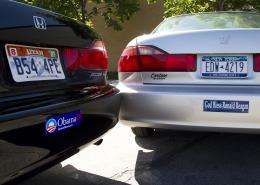Voters in red states and blue states virtually the same on the issues, study shows

(PhysOrg.com) -- Take a random person from a so-called “red state,” and the odds are nearly 50/50 that he or she would actually be more liberal on political issues than a random resident of a “blue state.”
More specifically, the chances of any one red state citizen scoring more liberal than a blue state citizen are 46 percent on economic issues and 51 percent on social issues.
The research, conducted by political scientists at the University of Pennsylvania and Brigham Young University, paints an entirely different picture of American politics than the popular narrative of a polarized society.
“Far from being from two separate planets, red and blue state citizens seem to inhabit the same neighborhood,” wrote BYU’s Jeremy Pope and Penn’s Matthew Levendusky.
Casting party labels aside, the researchers instead examined data that simply showed how people felt about the issues. The next step was to measure how much common ground is shared by voters from so-called red and blue states.
The premise of polarization didn’t hold up even when the analysis was limited to states considered to be at the extremes of the conservative-liberal scale. Take Utah and New York, for example. The researchers calculate that 77 percent of voters in those two states occupy common ground when it comes to social policy, and 69 percent shared common ground on economic issues.
“Utah is more conservative than it’s not, but the number of liberals is substantial,” Pope said. “The overall picture is more complicated. There are lots of conservatives in New York. You can find a similar pattern in any pair of states.”
So where does the perception of a polarized political landscape come from? Certainly the media’s penchant for telling “both sides” of the story contributes. Other political scientists have documented that the primary election process favors candidates that are not centrists.
But the biggest take-away from this study is that comparing one state’s average voter to another’s just doesn’t tell the whole story.
“It doesn’t make very much sense to look at the ‘average voter’ and believe you have a sense of everything,” Pope said.
The study will appear in the new issue ofPublic Opinion Quarterly.
Provided by Brigham Young University
















